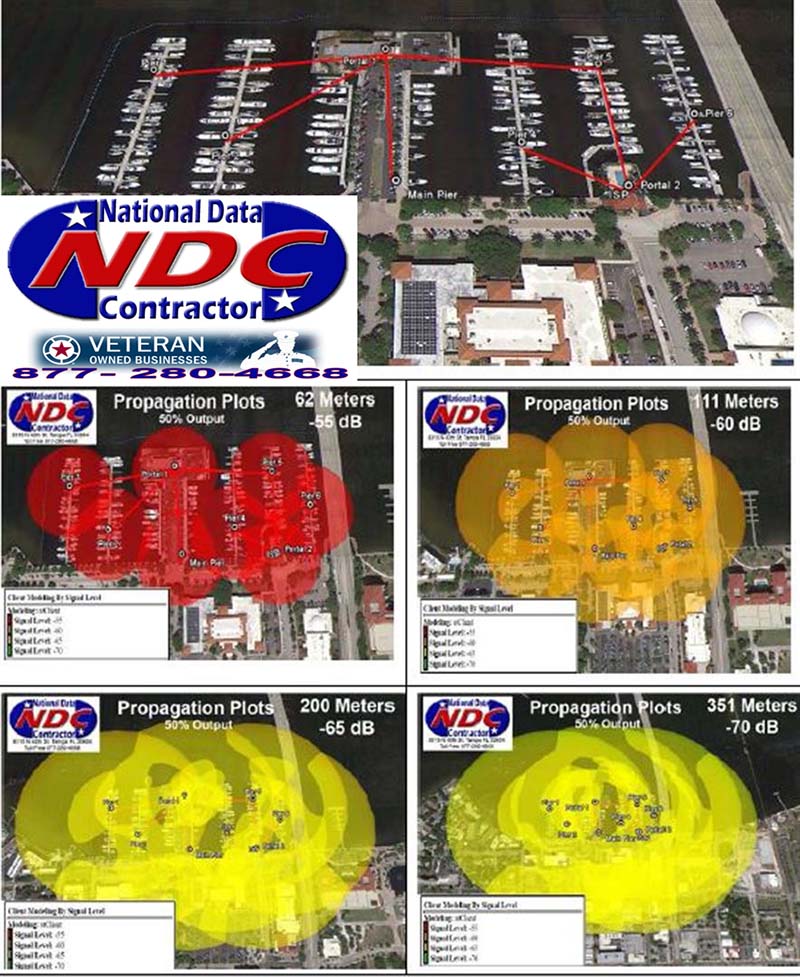A Wi-Fi installation and design contractor should provide a comprehensive process of assessing, designing, installation, and certifying Wi-Fi signal levels in buildings
 Reliable Wi-Fi connectivity is vital for businesses, organizations, and individuals alike, yet so many buildings we survey have obvious coverage issues, whether from building structure, other devices, or poor installations.. Wi-Fi installation and design are two essential components that must go hand in hand.
Reliable Wi-Fi connectivity is vital for businesses, organizations, and individuals alike, yet so many buildings we survey have obvious coverage issues, whether from building structure, other devices, or poor installations.. Wi-Fi installation and design are two essential components that must go hand in hand.
These elements are listed in reverse order because we are often brought in to install a network that has already been designed by someone else, so why not take advantage of the Wi-Fi installation search! While we would prefer to handle both aspects of the process, many companies allocate the design responsibilities to their IT team. This can result in suboptimal design choices, which are quickly identified during testing. It is at this point that we step in as Wi-Fi design and installation contractor to address any issues and create a more effective network solution for our clients.
Ensuring optimal Wi-Fi signal levels within buildings is essential for optimized connectivity and productivity. This comprehensive process involves checking existing signal levels, benchmark them, creating propagation heat maps based on system and access point (AP) placement, and finally certifying the network with a final benchmark test, in its basic explanation.
Wi-Fi Installation and Design: Initial Assessment:
NDC's process begins with an initial assessment of the building's Wi-Fi signal levels. This involves deploying our technicians equipped with specialized tools to conduct a thorough survey of the premises. During this phase, our techs identify areas with weak or no signal coverage, potential sources of interference, and any structural obstacles that may hinder signal propagation. The assessment also takes into account the building's layout, materials used in construction, and environmental factors that could affect signal strength.
Benchmark Existing Levels:
Once the initial assessment is complete, we always benchmark the existing Wi-Fi signal levels throughout the building. This step involves taking measurements at various locations to establish a baseline for signal strength after commissioning. Benchmark testing Wi-Fi helps identify areas where signal levels are below acceptable thresholds and dictates subsequent steps in the optimization process. Detailed documentation of benchmarked signal levels is essential for comparison and evaluation during later stages.
Signal Injection Testing:
Using our signal generator and pole mount antennas, we dial in a specific frequency to generate and simulate the Wi-Fi signal. Our techs then walk the building and perform a grid test with a spectrum analyzer to gauge signal penetration levels accurately. This data is crucial for the propagation prediction and placement analysis that follows. By assessing how the signal propagates through various building materials and obstacles, engineers can anticipate areas of potential signal degradation or interference. This information informs the strategic placement of access points to ensure optimal coverage and performance throughout the building. Through meticulous testing and analysis, our methods will fine-tune the Wi-Fi network's configuration to mitigate potential coverage gaps and ensure reliable connectivity for users across all areas of the building.
Propagation Heat Map Generation:
With benchmark data in hand, including our signal injected data, our designers utilize specialized software to generate propagation heat maps. These heat maps provide a visual representation of predicted Wi-Fi signal strength throughout the building based on the planned placement of Wi-Fi access points. We take into account factors such as building layout, materials, antenna characteristics, and AP configurations to simulate signal propagation accurately. By analyzing the heat maps, our RF engineers can optimize AP placement and system configuration to maximize signal coverage and minimize dead zones.
Anticipated Levels Based on Placement:
Our next procedure involves analyzing the propagation heat maps to determine anticipated Wi-Fi signal levels based on system head end and AP placement. We identify optimal locations for AP installation to achieve uniform coverage throughout the building. Strategic placement takes into consideration factors such as signal overlap, channel utilization, users, and interference sources to ensure optimal performance. By fine-tuning AP placement and configuration based on heat map analysis and signal injection testing, we deign for reliable Wi-Fi connectivity across all areas of the building.
Certification with Final Benchmark Test:
Once the APs are installed and configured according to the propagation heat map recommendations and network preferences, a final benchmark grid test is conducted to certify the Wi-Fi network against the baseline benchmark, and to industry standard final signal levels. During this test, our techs measure signal levels at predefined locations throughout the building to verify that the actual signal strength aligns with the anticipated levels predicted by the heat maps, and our injected signal levels. Any discrepancies or areas of concern are quickly identified and addressed to ensure optimal performance. Certification of the Wi-Fi network involves validating that it meets predefined performance criteria and is ready for operational use.
The process of checking a building for Wi-Fi signal levels, benchmark testing existing levels, injecting our own signal for testing building penetration levels, generating propagation heat maps, and certifying the network is a meticulous and comprehensive endeavor. By following a systematic approach that combines technical expertise, specialized tools, and advanced software, our team can optimize Wi-Fi signal coverage and performance within buildings of varying sizes and complexities, as well as outdoor spaces. Effective Wi-Fi optimization enhances connectivity, productivity, and user satisfaction while mitigating potential issues such as dropped connections and slow data speeds. As the demand for wireless connectivity continues to grow, ensuring reliable Wi-Fi coverage within buildings remains a critical priority for organizations across industries.
